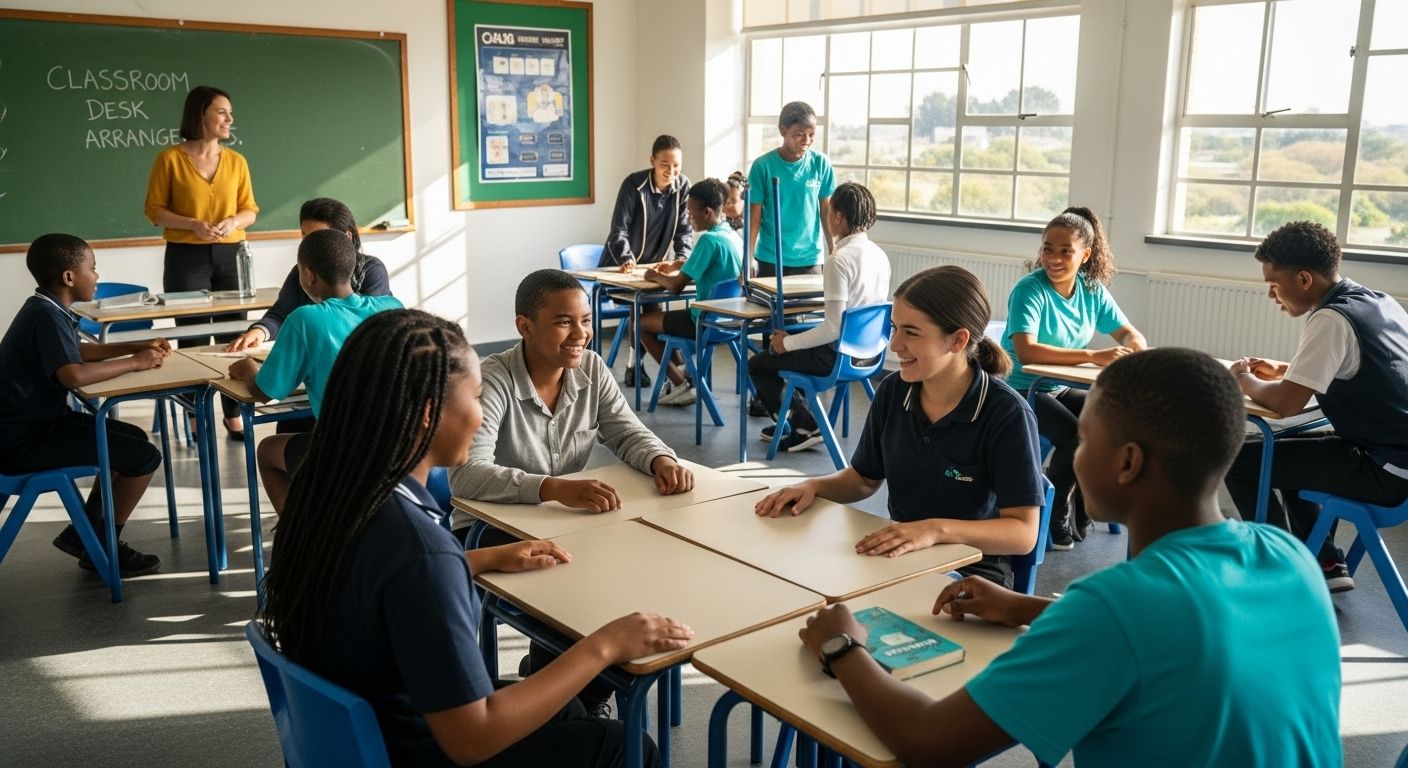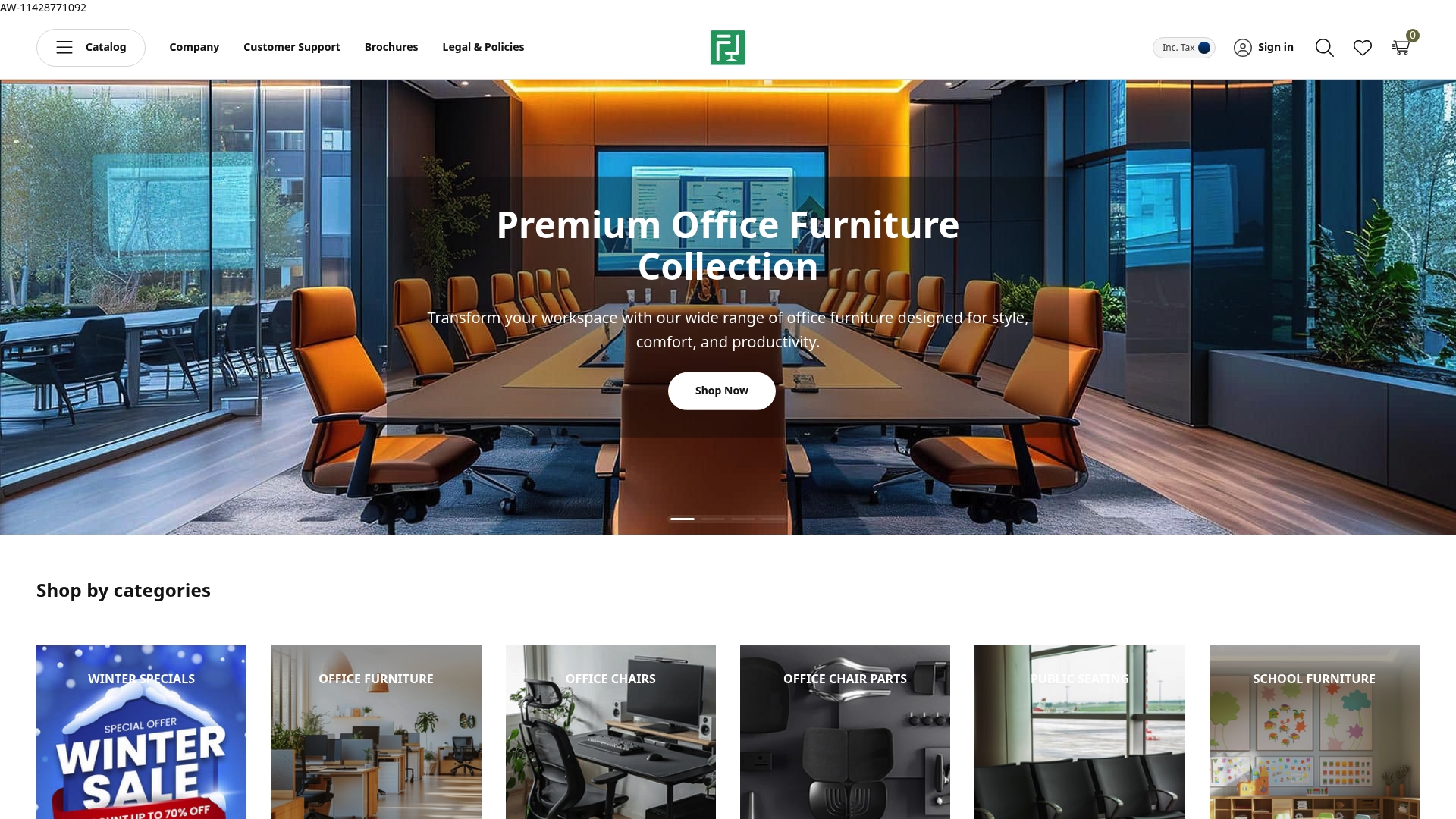How to Arrange Classroom Desks in South Africa for 2025
Aug 05, 2025
How to Arrange Classroom Desks in South Africa for 2025

Classroom desk arrangements might seem like a small detail in South African schools, yet the way desks are placed can make or break the flow of learning. Picture this. Switching from traditional rows to collaborative clusters has shown to boost student engagement by up to 40 percent. Most people think it’s just about fitting desks into a room, but the real magic happens when layout actually transforms the way kids connect, move, and learn together.
Table of Contents
- Understanding Different Desk Arrangements
- Adapting Desk Layouts For Various Spaces
- Tips For Easy Movement And Group Work
- Maintenance And Safety For Desk Setups
Quick Summary
| Takeaway | Explanation |
|---|---|
| Adapt desk layouts for learning styles | Use flexible configurations like clusters or U-shapes to accommodate different student needs and encourage interaction. |
| Prioritize mobility and accessibility | Ensure clear pathways and use lightweight furniture to facilitate movement and support students with mobility challenges. |
| Conduct regular maintenance inspections | Implement quarterly checks to maintain furniture quality and address potential hazards promptly, enhancing safety. |
| Incorporate technology-friendly designs | Design layouts that facilitate access to power outlets and digital resources for collaborative learning experiences. |
| Focus on sustainable furniture solutions | Choose durable, eco-friendly materials to enhance safety, reduce long-term costs, and minimize environmental impact. |
Understanding Different Desk Arrangements
Classroom desk arrangements are more than just spatial organization they are strategic tools that significantly impact learning environments and student engagement. In South African educational settings, understanding the nuanced approaches to desk configuration can transform traditional teaching spaces into dynamic learning zones.
Traditional vs Modern Classroom Layouts
Traditional classroom designs typically featured rows of desks facing forward, emphasizing teacher-centered instruction. However, modern educational research suggests more flexible and interactive arrangements. A study by the University of Pretoria reveals that innovative desk configurations can improve student interaction, collaboration, and overall academic performance.
The conventional grid layout, where students sit in uniform rows, has long been the standard in many South African schools. This arrangement prioritizes individual work and direct teacher supervision. While this method has historical roots in disciplined learning environments, contemporary pedagogical approaches challenge its effectiveness. Modern educators recognize that classroom desk arrangements should facilitate multiple learning styles and promote active participation.
Collaborative Desk Configurations
Collaborative desk arrangements have gained significant traction in progressive educational settings. These configurations typically involve grouping desks in clusters or circular formations that encourage peer interaction and group work. Research from the South African Journal of Education indicates that such arrangements can boost student engagement by up to 40%.
These configurations might include:
- Cluster Groups: 4-6 desks arranged to form small collaborative zones
- U-shaped Layouts: Desks positioned to create an open learning space
- Horseshoe Configurations: Semicircular arrangements that facilitate class discussions
Each arrangement offers unique benefits. Cluster groups promote teamwork and peer learning, while U-shaped and horseshoe layouts enhance teacher-student interactions and facilitate more dynamic classroom discussions. The key is flexibility and adaptability to different teaching methodologies and learning objectives.
To give a clear comparison of the main desk arrangement types and their key benefits, here is a summary table:
| Arrangement Type | Description | Primary Benefits |
|---|---|---|
| Traditional Rows | Desks in straight, forward-facing lines | Individual focus, teacher control |
| Cluster Groups | 4-6 desks grouped together | Teamwork, peer learning, collaboration |
| U-Shaped Layout | Desks form a U within the classroom | Enhanced interaction, visibility, discussion |
| Horseshoe Configuration | Semicircular, open-ended desk arrangement | Facilitates discussion, teacher movement |
Ergonomic and Spatial Considerations

Beyond pedagogical strategies, desk arrangements must also consider physical comfort and spatial efficiency. Ergonomic research emphasizes the importance of creating learning spaces that support student health and minimize physical strain.
Considerations include:
- Adequate space between desks
- Proper lighting and visibility
- Accessibility for students with mobility challenges
- Potential for quick reconfiguration during different learning activities
Classroom desk arrangements are not one-size-fits-all solutions. They require thoughtful planning, understanding of educational goals, and a commitment to creating inclusive, engaging learning environments. South African educators must continually evolve their approach, balancing traditional teaching methods with innovative spatial designs that support holistic student development.
For those interested in exploring more about creating optimal learning spaces, our guide on classroom furniture solutions offers comprehensive insights into modern educational design strategies.
Adapting Desk Layouts for Various Spaces
Effective classroom desk arrangements require nuanced strategies that accommodate diverse learning environments, spatial constraints, and educational objectives. In South African schools, adapting desk layouts is not merely about physical organization but creating flexible, inclusive spaces that support dynamic learning experiences.
Space Optimization Strategies
Space optimization represents a critical consideration when arranging classroom desks. Research from EDUCAUSE Review highlights seven essential principles for successful learning space design, emphasizing environmental quality and layout flexibility. These principles underscore the importance of anticipating not just what learners will use, but precisely how they will utilize educational spaces.
Classroom configurations must balance multiple competing requirements: maintaining clear movement pathways, ensuring adequate seating density, enabling easy reconfiguration, preserving visibility of learning activities, and prioritizing student comfort. This delicate equilibrium demands thoughtful planning and strategic furniture selection.
Flexible Learning Environments
Modern educational approaches prioritize adaptable learning environments that can rapidly transform to support different pedagogical techniques. Edutopia’s research reveals that seating arrangements should fundamentally align with specific learning tasks and students’ individual characteristics.
Innovative layout options include:
- L-shaped seating pods: Facilitating small group interactions
- Circular arrangements: Promoting collaborative discussions
- Modular desk configurations: Enabling quick spatial transformations
These flexible designs allow educators to create dynamic learning zones that seamlessly transition between individual study, group work, and whole-class instruction. The ability to quickly reconfigure spaces supports diverse teaching methodologies and accommodates varied learning styles.
Specialized Space Considerations
Different educational spaces require tailored desk arrangement approaches. Education Corner’s research emphasizes creating active learning classrooms with movable furniture that supports intellectual and social interactions.
Considerations for specialized spaces include:
- Science laboratories requiring clear pathways and experimental zones
- Computer rooms needing structured yet accessible technological setups
- Art studios demanding flexible, adaptable workspace configurations
- Inclusive classrooms supporting students with mobility challenges
In South African educational contexts, these adaptable layouts must also address practical challenges such as limited resources, varied classroom sizes, and diverse student needs. Our comprehensive furniture solutions guide provides deeper insights into creating effective, versatile learning environments.
Ultimately, successful desk arrangements transcend mere spatial organization. They represent strategic tools for enhancing student engagement, supporting diverse learning styles, and creating inclusive educational experiences that empower students to explore, collaborate, and grow.
Tips for Easy Movement and Group Work
Creating classroom environments that facilitate seamless movement and collaborative learning requires strategic planning and intentional design. South African educators increasingly recognize the importance of designing spaces that support dynamic interactions and flexible learning experiences.
Designing for Mobility and Accessibility
Research from the Universal Design for Learning Guidelines emphasizes the critical role of providing students with multiple means of engagement and movement. Classroom layouts should prioritize clear pathways that allow students to transition between individual and group work with minimal disruption.
Key mobility considerations include:
- Maintaining wide walkways between desk clusters
- Creating designated movement zones
- Ensuring sufficient space for students with mobility challenges
- Implementing furniture with lightweight, easily movable designs
Accessibility goes beyond physical movement. It encompasses creating an inclusive environment where every student can participate comfortably and confidently. This means considering factors like desk height, chair adjustability, and overall spatial configuration that supports diverse learning needs.
Below is a checklist table of essential design and accessibility considerations for movement-friendly classrooms:
| Consideration | Status/Guidelines |
|---|---|
| Wide walkways between desks | Ensure at least 80cm for easy passage |
| Designated movement zones | Mark areas for transitions |
| Space for mobility device users | Plan routes with no obstructions |
| Lightweight, movable furniture | Prefer chairs/tables under 12kg |
| Adjustable desk and chair height | Provide for varying student needs |
| Unobstructed access to exits | Keep emergency routes clear |
Strategies for Effective Group Work
A study by the South African Journal of Education reveals that well-structured group work can significantly enhance student learning outcomes. Effective group configurations require deliberate planning and strategic desk arrangements that promote interaction and collaboration.
Essential strategies for group work include:
- Quick Reconfiguration: Using lightweight, movable desks that can be rapidly arranged
- Mixed Ability Grouping: Creating diverse groups that encourage peer learning
- Clear Interaction Zones: Designing spaces that facilitate communication
- Technology Integration: Ensuring groups have access to shared digital resources
Successful group work environments balance structure with flexibility. The goal is to create spaces that naturally encourage dialogue, knowledge sharing, and collective problem-solving.
Technology and Movement-Friendly Layouts
Modern classrooms must integrate technological considerations into their spatial design. Educational Technology Research highlights the importance of creating layouts that support digital collaboration while maintaining physical movement capabilities.
Technology-friendly layout principles include:
- Positioning power outlets strategically
- Creating shared digital workspaces
- Ensuring wireless connectivity across different desk configurations
- Implementing charging stations within collaborative zones
These approaches transform traditional classroom spaces into dynamic learning environments that adapt to evolving educational technologies and pedagogical approaches.
Implementing these strategies requires a holistic approach. Educators must continuously assess and adjust classroom layouts to meet changing student needs. [Explore our comprehensive classroom furniture solutions for practical implementation strategies that support modern learning environments.
Ultimately, creating movement-friendly and collaborative classrooms is about more than furniture arrangement. It is about designing spaces that inspire learning, encourage interaction, and support every student’s unique educational journey.
Maintenance and Safety for Desk Setups
Ensuring the safety and longevity of classroom desk setups requires a comprehensive approach that goes beyond simple aesthetic considerations. In South African educational environments, proactive maintenance and strategic safety protocols are essential for creating sustainable learning spaces that protect both students and institutional investments.
Regular Inspection and Maintenance Protocols
The National Institute for Occupational Safety and Health (NIOSH) provides critical guidelines for classroom furniture maintenance that emphasize systematic inspection and timely repairs. Regular assessment of desk conditions can prevent potential hazards and extend furniture lifespans.
Key maintenance strategies include:
- Conducting quarterly comprehensive furniture inspections
- Checking for structural integrity of desk frames
- Identifying and immediately addressing loose bolts or connections
- Examining surface conditions for splinters, cracks, or damage
- Documenting and tracking maintenance history for each piece of furniture
Schools should develop a standardized maintenance checklist that covers visual, structural, and functional aspects of classroom furniture. This proactive approach not only ensures student safety but also optimizes long-term financial resources by preventing premature furniture replacement.
The following table summarises the recommended furniture inspection checklist to maintain safe and durable desk setups:
| Maintenance Task | Frequency | Key Action Points |
|---|---|---|
| Comprehensive desk/frame inspection | Quarterly | Check for wobble, cracks, loose parts |
| Tighten bolts and hardware | Quarterly | Ensure all connections are secure |
| Surface damage check | Quarterly | Inspect for splinters, chips, water damage |
| Documentation of repairs/maintenance | Ongoing | Keep records for each furniture item |
| Review for ergonomic risks | Annually | Assess desk/chair height, spacing, comfort |
Safety Considerations in Desk Arrangement
Research from the South African Department of Basic Education highlights the importance of strategic desk placement in minimizing potential risks. Safety goes beyond physical furniture condition and encompasses how desks are positioned within learning spaces.
Critical safety considerations include:
- Maintaining clear emergency evacuation pathways
- Ensuring adequate spacing between desk clusters
- Avoiding configurations that block classroom exits
- Creating accessible routes for students with mobility challenges
- Implementing arrangements that facilitate quick movement during emergencies
Additionally, desk arrangements should account for potential ergonomic risks. Proper height, appropriate spacing, and consideration of individual student needs can prevent long-term physical strain and support healthy learning environments.
Sustainable and Durable Furniture Solutions
Investing in high-quality, durable classroom furniture represents a strategic approach to long-term safety and maintenance. Sustainable design principles emphasize selecting materials and constructions that withstand frequent use while minimizing environmental impact.
Considerations for sustainable desk solutions include:
- Using recyclable and eco-friendly materials
- Selecting furniture with modular design for easy repair
- Choosing surfaces resistant to wear and chemical damage
- Prioritizing locally manufactured products to reduce transportation emissions
- Implementing furniture with adjustable configurations
Our comprehensive guide to classroom furniture solutions offers insights into selecting durable, safe, and adaptable learning environment furnishings.
Maintaining safe and functional classroom desk setups is an ongoing process that requires commitment, systematic planning, and a holistic understanding of educational space design. By prioritizing regular maintenance, strategic safety protocols, and sustainable furniture solutions, South African schools can create learning environments that support student well-being and educational excellence.

Frequently Asked Questions
How can different desk arrangements impact student engagement?
Changing from traditional rows to collaborative clusters can boost student engagement by up to 40%. Arrangements that encourage interaction enhance learning experiences.
What are the benefits of using collaborative desk configurations?
Collaborative desk configurations, such as cluster groups or U-shaped layouts, promote teamwork, peer learning, and more dynamic classroom discussions, enhancing overall academic performance.
How should classroom desk arrangements accommodate students with mobility challenges?
Desk arrangements should ensure clear pathways, use lightweight furniture, and provide adjustable desk heights to create an inclusive environment for students with mobility challenges.
What maintenance practices are essential for classroom desk setups?
Regular inspections, including checking for structural integrity, tightening bolts, and evaluating surface conditions, should be conducted quarterly to ensure safety and durability of classroom furniture.
Ready to Transform Your Classroom for 2025?
Is your school struggling with outdated desk arrangements, cramped walkways, or inflexible classroom spaces? In this guide, you saw how much the right setup can boost engagement and unlock the full potential of every learner. But achieving flexible and ergonomic layouts is challenging when you don’t have the right furniture or expert guidance.

At Office Stock, we help South African schools and institutions bring their classroom vision to life. Whether you need durable desks for quick layout changes, furniture for accessible pathways, or smart storage to free up space, our premium office furniture range supports all teaching styles and classroom sizes. Visit our comprehensive solutions page to find ergonomic desks and flexible options designed for South African classrooms. Take the next step and create a safe, inspiring environment for your learners before the new academic year arrives.
